Fraction Swap: The BEST Fraction Game EVER!
What educators are saying
Description
*Distance Learning... This game works really well if students can print fraction tiles OR visit a website with free fraction tile online manipulative (try https://toytheater.com/fraction-strips/)
Hello teachers!
This fraction game is a powerful tool in building concrete understanding of fractions.
Included with this game is a detailed lesson plan, 3rd, 4th, and 5th grade Common Core standards, learning targets, and discussion questions. There are also game cards, fraction pieces (printable fraction tiles), and game boards.
Through playing this game...
3rd graders will build understanding of unit fractions, equivalent fractions, and comparing fractions.
4th graders will strengthen their understanding of comparing fractions and make connections between adding and multiplying fractions.
5th graders will be introduced to multiplying and dividing fractions.
All students will make connections and see number patterns as they play this game throughout the school year.
I hope you love this game as much and my students and I do!
Happy Teaching!
Jeannie Curtis
www.elementarymathconsultant.com
Want to earn TpT credit?
From your My Purchases page, click Provide Feedback. You'll earn credit towards future purchases every time you rate a product! Also, I find it super helpful to see your ratings and read your comments, so thank you!
You can also learn about my new products and sales by following me. Just click the green star on my store page!
Check out all the standards you'll address with this game:
3rd grade:
CCSS.MATH.CONTENT.3.NF.A.3
Explain equivalence of fractions in special cases, and compare fractions by reasoning about their size.
CCSS.MATH.CONTENT.3.NF.A.3.A
Understand two fractions as equivalent (equal) if they are the same size, or the same point on a number line.
CCSS.MATH.CONTENT.3.NF.A.3.B
Recognize and generate simple equivalent fractions, e.g., 1/2 = 2/4, 4/6 = 2/3. Explain why the fractions are equivalent, e.g., by using a visual fraction model.
CCSS.MATH.CONTENT.3.NF.A.3.C
Express whole numbers as fractions, and recognize fractions that are equivalent to whole numbers. Examples: Express 3 in the form 3 = 3/1; recognize that 6/1 = 6; locate 4/4 and 1 at the same point of a number line diagram.
CCSS.MATH.CONTENT.3.NF.A.3.D
Compare two fractions with the same numerator or the same denominator by reasoning about their size. Recognize that comparisons are valid only when the two fractions refer to the same whole. Record the results of comparisons with the symbols >, =, or <, and justify the conclusions, e.g., by using a visual fraction model.
CCSS.MATH.CONTENT.3.NF.A.1
Understand a fraction 1/b as the quantity formed by 1 part when a whole is partitioned into b equal parts; understand a fraction a/b as the quantity formed by a parts of size 1/b.
4th grade:
"CCSS.MATH.CONTENT.4.NF.A.1
Explain why a fraction a/b is equivalent to a fraction (n × a)/(n × b) by using visual fraction models, with attention to how the number and size of the parts differ even though the two fractions themselves are the same size. Use this principle to recognize and generate equivalent fractions.
CCSS.MATH.CONTENT.4.NF.A.2
Compare two fractions with different numerators and different denominators, e.g., by creating common denominators or numerators, or by comparing to a benchmark fraction such as 1/2. Recognize that comparisons are valid only when the two fractions refer to the same whole. Record the results of comparisons with symbols >, =, or <, and justify the conclusions, e.g., by using a visual fraction model.
Understand a fraction a/b with a > 1 as a sum of fractions 1/b.
CCSS.MATH.CONTENT.4.NF.B.3.A
Understand addition and subtraction of fractions as joining and separating parts referring to the same whole.
CCSS.MATH.CONTENT.4.NF.B.3.B
Decompose a fraction into a sum of fractions with the same denominator in more than one way, recording each decomposition by an equation. Justify decompositions, e.g., by using a visual fraction model. Examples: 3/8 = 1/8 + 1/8 + 1/8 ; 3/8 = 1/8 + 2/8 ; 2 1/8 = 1 + 1 + 1/8 = 8/8 + 8/8 + 1/8.
CCSS.MATH.CONTENT.4.NF.B.4
Apply and extend previous understandings of multiplication to multiply a fraction by a whole number.
CCSS.MATH.CONTENT.4.NF.B.4.A
Understand a fraction a/b as a multiple of 1/b. For example, use a visual fraction model to represent 5/4 as the product 5 × (1/4), recording the conclusion by the equation 5/4 = 5 × (1/4).
CCSS.MATH.CONTENT.4.NF.B.4.B
Understand a multiple of a/b as a multiple of 1/b, and use this understanding to multiply a fraction by a whole number. For example, use a visual fraction model to express 3 × (2/5) as 6 × (1/5), recognizing this product as 6/5. (In general, n × (a/b) = (n × a)/b.)"
5th grade:
"CCSS.MATH.CONTENT.5.NF.A.1
Add and subtract fractions with unlike denominators (including mixed numbers) by replacing given fractions with equivalent fractions in such a way as to produce an equivalent sum or difference of fractions with like denominators. For example, 2/3 + 5/4 = 8/12 + 15/12 = 23/12. (In general, a/b + c/d = (ad + bc)/bd.)
CCSS.MATH.CONTENT.5.NF.B.7.A
Interpret division of a unit fraction by a non-zero whole number, and compute such quotients. For example, create a story context for (1/3) ÷ 4, and use a visual fraction model to show the quotient. Use the relationship between multiplication and division to explain that (1/3) ÷ 4 = 1/12 because (1/12) × 4 = 1/3."





